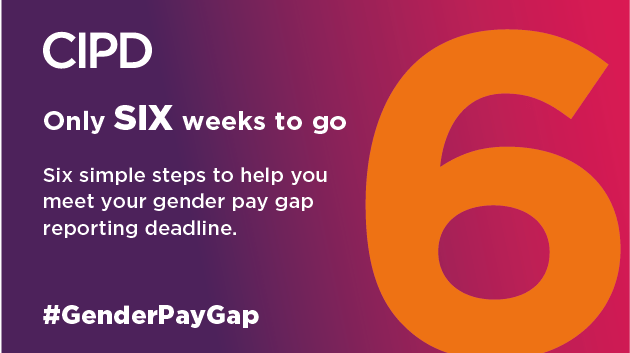
With just six weeks left to go before the deadline for submitting gender pay gap reports (30 March for public sector employers and 4 April for those in the private and voluntary sectors), thousands of eligible organisations are yet to submit their reports on the government website.
To help those yet to meet their legal duty to report, the CIPD has highlighted six simple steps they can follow – to meet the reporting requirements and play their role in closing the gender pay gap. Most importantly though, the professional body is also urging HR teams to make closing the gender pay gap a year-round priority, not just an annual tick-box exercise.
Meet this year’s deadline in six simple steps
If you haven’t already compiled your gender pay gap report, here are six simple steps you can follow:
1. Capture and analyse the right data
You must base your gender pay gap report on the relevant snapshot date for your sector: 31 March 2019 for the public sector, or 5 April 2019 for private and voluntary organisations. There are six key measures you need to report and it’s important to make sure you include all relevant employees and workers, including casual workers.
2. Work out what’s causing your gender pay gap
Several factors can influence an organisation’s gender pay gap. It’s important to understand which of these are driving your gender pay gap so you can explain it to stakeholders and take the right actions to help close your gap. You may need to make changes within your organisation or work in collaboration with other employers in your sector or local area to address long-standing occupational or industry-wide issues. A thorough understanding of what’s driving your gender pay gap can also give you greater insights into your organisation’s culture and the wider risks and opportunities your business faces.
The key drivers of gender pay gaps include:
- high proportions of women in low-paid, part-time roles
- high proportions of women taking on unpaid caring responsibilities
- differences in human capital
- men dominating some types of jobs and women others
- undervaluing of women’s work
- pay discrimination (where a man is illegally paid more than a woman for work of the same value).
3. Review your action plan
If, like most employers, you’re reporting your gender pay gap for the second or third time this year, you should already have identified the steps your organisation is committed to taking to close the gender pay gap. Your action plan should be long-term and a year-round priority, but the annual reporting deadline is a good opportunity to review the progress your organisation is making, assess what is and isn’t working, and identify any additional actions you may need to take.
Reviewing your action plan will help you prepare a meaningful narrative to accompany your gender pay gap data, and could also help you identify steps you can take to help your organisation prosper in the long term.
4. Tell your story
Although not a current reporting requirement, it makes good business sense to submit a narrative along with your gender pay gap data, to put your gender pay gap into context. This is your opportunity to protect and even enhance your organisation's reputation, by explaining what’s causing your pay gap and highlighting the actions you’re taking to address it. If your pay gap has widened in recent years because of actions you’re taking to close the gap in the longer-term, this is your chance to explain.
5. Prepare your communications plan
Once you’ve published your gender pay gap data, it will be in the public domain for anyone to find – including current or prospective employees, customers or investors. A proactive communications plan, making sure you equip the right people, with the right information, at the right time, will help you ward off negative reactions to your gender pay gap data and draw attention to the positive steps you’re taking. .
Sequencing your communications is particularly important; make sure your employees hear about your gender pay gap from you first, not the media.
6. Submit your report
You must publish your gender pay gap data on both the government gender pay gap reporting service website and your organisation’s website no later than 30 March for public sector organisations and 4 April for private and voluntary sector employers. Failure to do so is a breach of the Equality Act 2010 and the public viewing website highlights late reports.
When you publish your data on your organisation’s website, you must make it easily accessible to employees and the public (no more than three clicks from your home page), and ensure it remains there for at least three years.
For more detail on each of the six steps highlighted in this article, follow the CIPD’s six-week countdown to the gender pay gap reporting deadline on Twitter, LinkedIn and Facebook.
Media centre
Are you a journalist looking for expert commentary and insights on the world of work?

Championing better work and working lives
About the CIPD
At the CIPD, we champion better work and working lives. We help organisations to thrive by focusing on their people, supporting economies and society for the future. We lead debate as the voice for everyone wanting a better world of work.




